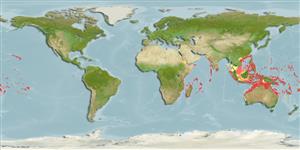Actinopterygii (ray-finned fishes) >
Perciformes (Perch-likes) >
Acanthuridae (Surgeonfishes, tangs, unicornfishes) > Nasinae
Etymology: Naso: Latin, nasus = nose (Ref. 45335).
Environment / Climate / Range
Ecology
Marine; brackish; reef-associated; depth range 6 - 150 m (Ref. 30573), usually 10 - 137 m (Ref. 27115). Tropical; 25°C - 28°C (Ref. 27115), preferred ?; 24°N - 32°S, 30°E - 145°W (Ref. 57251)
Indo-Pacific: Red Sea and East Africa (Ref. 9710), including the Mascarene Islands (Ref. 37792) to the Hawaiian, Marquesas and Ducie islands, north to southern Japan, south to Lord Howe Island.
Length at first maturity / Size / Weight / Age
Maturity: Lm 45.0 range ? - ? cm
Max length : 75.0 cm FL male/unsexed; (Ref. 1602); common length : 50.0 cm TL male/unsexed; (Ref. 30573)
Dorsal
spines
(total): 6;
Dorsal
soft rays
(total): 27-29;
Anal
spines: 2;
Anal
soft rays: 27 - 30. Almost fusiform, body grayish to greenish brown, paler below. Two weak immovable bucklers on each side of caudal peduncle. Without horn; short groove in front of eye. Yellowish brown preopercular margin. Over 25 cm with black tongue. Skin granulated or velvety. Teeth small and slender, close-set and pointed. Caudal fin emarginate in young.
Inhabits clear lagoon and seaward reef slopes (Ref. 9710, 48637). Benthopelagic (Ref. 58302). Usually seen in large schools (Ref. 90102). Mainly diurnal, it feeds on zooplankton such as crab larvae, arrow worms, pelagic tunicates, and occasionally filamentous red algae. The species is never poisonous (Ref. 4795).
Life cycle and mating behavior
Maturity | Reproduction | Spawning | Eggs | Fecundity | Larvae
Spawn in pairs (Ref. 240).
Myers, R.F., 1991. Micronesian reef fishes. Second Ed. Coral Graphics, Barrigada, Guam. 298 p. (Ref. 1602)
IUCN Red List Status (Ref. 115185)
CITES (Ref. 94142)
Not Evaluated
Human uses
Fisheries: commercial; gamefish: yes; aquarium: commercial
More information
ReferencesAquacultureAquaculture profileStrainsGeneticsAllele frequenciesHeritabilityDiseasesProcessingMass conversion
Tools
Special reports
Download XML
Internet sources
